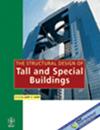基于随机森林算法和增强灰狼优化的矩架震害识别
IF 1.3
3区 工程技术
Q3 CONSTRUCTION & BUILDING TECHNOLOGY
引用次数: 1
摘要
本研究旨在通过将随机森林(RF)机器分类器和增强型灰狼优化器(EGWO)元启发式算法相结合,使用地震响应识别二维(2D)力矩框架中的损伤。首先,使用有限元法(FEM)模拟了用于动力分析的二维力矩框架。然后,使用所提出的最优传感器布置(POSP)方法对传感器的布置进行优化,该方法是迭代改进约简系统(IIRS)和二元微分进化(BDE)优化算法的组合。对1995年神户地震作用下具有损伤单元的力矩框架在最佳传感器位置下的加速度响应进行了测量。然后,使用具有外源输入法(ARX)的自回归模型作为系统识别方法,提取结构的固有频率和振型。利用固有频率来训练RF机器学习网络,该网络可以找到力矩框架的损坏情况。然后,采用EGWO来准确定位和量化结构的损坏元件。通过考虑具有18个单元的六层框架、具有49个单元的七层框架以及八层框架在各种条件下的实验数据来评估所提出方法的效率。结果表明,RF算法在正确查找受损楼层方面具有突出的性能。此外,通过EGWO算法精确地确定了受损元件的位置和严重程度。最终结果表明,所提出的两步方法在地震识别此类结构的损伤方面非常有效。本文章由计算机程序翻译,如有差异,请以英文原文为准。
Seismic damage identification of moment frames based on random forest algorithm and enhanced gray wolf optimization
The present study aims to identify damage in two‐dimensional (2‐D) moment frames using seismic responses by combining the random forest (RF) machine classifier and the enhanced gray wolf optimizer (EGWO) metaheuristic algorithm. First, a 2‐D moment frame for the dynamic analysis is simulated using the finite element method (FEM). Then, the placement of sensors is optimized using a proposed optimal sensor placement (POSP) method, which is a combination of the iterated improved reduced system (IIRS) and the binary differential evolution (BDE) optimization algorithm. The acceleration responses of the moment frame having damaged elements under 1995 Kobe earthquake are measured at the optimal sensor placement. Then, the natural frequencies and mode shapes of the structure are extracted using the auto‐regressive model with exogenous input method (ARX) as a system identification method. The natural frequencies are exploited to train an RF machine learning network that can find the damaged story of the moment frame. Then, EGWO is employed to accurately locate and quantify the damaged elements of the structure. The efficiency of the proposed method is assessed through considering a six‐story frame with 18 elements, a seven‐story frame with 49 elements, and the experimental data of an eight‐story frame for various conditions. The results show that the RF algorithm has an outstanding performance to correctly find a damaged story. Furthermore, the location and severity of damaged elements are precisely determined by EGWO algorithm. As a final outcome, it is demonstrated that the two‐step proposed method is very effective in seismically identifying damage to such structures.
求助全文
通过发布文献求助,成功后即可免费获取论文全文。
去求助
来源期刊
CiteScore
5.30
自引率
4.20%
发文量
83
审稿时长
6-12 weeks
期刊介绍:
The Structural Design of Tall and Special Buildings provides structural engineers and contractors with a detailed written presentation of innovative structural engineering and construction practices for tall and special buildings. It also presents applied research on new materials or analysis methods that can directly benefit structural engineers involved in the design of tall and special buildings. The editor''s policy is to maintain a reasonable balance between papers from design engineers and from research workers so that the Journal will be useful to both groups. The problems in this field and their solutions are international in character and require a knowledge of several traditional disciplines and the Journal will reflect this.
The main subject of the Journal is the structural design and construction of tall and special buildings. The basic definition of a tall building, in the context of the Journal audience, is a structure that is equal to or greater than 50 meters (165 feet) in height, or 14 stories or greater. A special building is one with unique architectural or structural characteristics.
However, manuscripts dealing with chimneys, water towers, silos, cooling towers, and pools will generally not be considered for review. The journal will present papers on new innovative structural systems, materials and methods of analysis.

 求助内容:
求助内容: 应助结果提醒方式:
应助结果提醒方式:


